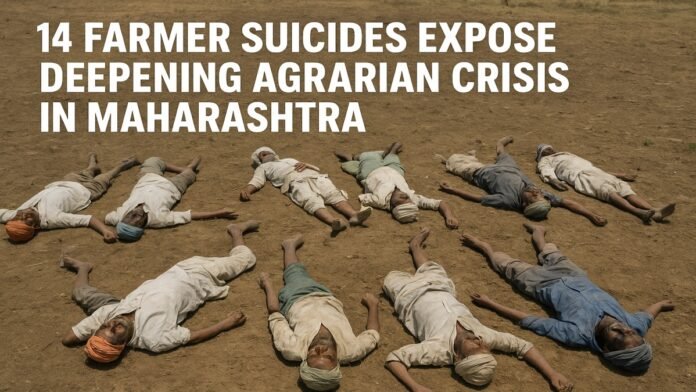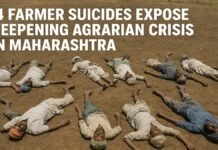
Key Points:
- Between October 10 and October 25, 2025, approximately 14 farmers in Wardha district, Maharashtra, died by suicide during the Diwali festival period, including a woman farmer whose family was overwhelmed by bank loan pressures highlighting an acute agrarian crisis in the region.
- Erratic and excessive rainfall destroyed crops across 4.32 lakh hectares of cultivated land in Wardha, including 2.25 lakh hectares of cotton and 1.5 lakh hectares of soybean, with farmers unable to recover even their input costs after investing heavily in expensive pesticides and disease-control measures that proved ineffective against recurring downpours.
- The consecutive crop failures following heavy losses during the 2024 Kharif season left farmers unable to harvest produce before Diwali, eliminating their primary income source while financial obligations including bank loan repayments, children’s education expenses, medical costs, and marriage-related expenses continued to accumulate.
- Despite government announcements of a relief package for distressed farmers, this financial assistance had not reached affected families even after the Diwali festival concluded, leaving farmers without support mechanisms to address their immediate debt crisis and survival needs.
- Agricultural experts and farmers’ organizations are demanding immediate government intervention including direct financial assistance, comprehensive loan waivers, and concrete support mechanisms to prevent further suicides and enable farming communities to regain economic stability.
Nagpur: The festival of Diwali, traditionally celebrated across India as a time of light, prosperity, and renewal, turned into a period of profound darkness and tragedy in Maharashtra’s Wardha district, where at least 14 farmers took their own lives between October 10 and October 25, 2025. The wave of suicides, occurring during what should have been a joyous celebration, has exposed the deepening agrarian crisis gripping rural Maharashtra, where consecutive crop failures, mounting debts, inadequate government support, and the crushing weight of financial obligations have pushed farming communities to the brink of despair.
The tragic toll includes a woman farmer who ended her life by jumping into a well, reportedly driven to desperation by the burden of bank loans threatening her family’s survival. Her death symbolizes the cascading crisis affecting entire farming households, not just individual cultivators, as financial distress radiates through families, affecting women, children, and elderly dependents who share the economic consequences of agricultural failure.
The crisis in Wardha represents a microcosm of broader structural challenges confronting Indian agriculture: climate unpredictability undermining traditional farming practices, inadequate crop insurance mechanisms, insufficient market price support systems, predatory lending structures, and delayed or ineffective government relief measures that fail to reach distressed farmers when intervention is most critical.
Consecutive Crop Failures Devastate Farming Communities
Wardha district’s agricultural calendar operates on the Kharif cropping season, the monsoon-dependent cultivation period from June to October that provides the primary income source for the region’s predominantly agrarian population. For the 2025 Kharif season, farmers across Wardha cultivated approximately 4.32 lakh hectares (432,000 hectares) of land, with cotton planted on 2.25 lakh hectares and soybean on 1.5 lakh hectares, representing the district’s two dominant cash crops.
After suffering devastating losses during the previous year’s 2024 Kharif season due to excessive rainfall that waterlogged fields and destroyed standing crops, farmers approached the 2025 season with cautious optimism and heavy investment in inputs, purchasing high-quality seeds, fertilizers, and expensive pesticides and fungicides to protect their crops from anticipated disease and pest pressures. Many farmers borrowed heavily from banks, cooperative societies, and private moneylenders to finance these input purchases, assuming that a successful harvest would enable loan repayment with sufficient surplus for household expenses.
However, erratic rainfall patterns throughout the 2025 monsoon season, characterized by extended dry spells followed by sudden intense downpours, created catastrophic conditions for crop development. Prolonged dry periods during critical growth phases weakened plants and made them vulnerable to pest infestations, particularly pink bollworm in cotton and various fungal diseases in soybean. When farmers responded by spraying expensive chemical pesticides and fungicides, subsequent heavy rainfall washed away these treatments, rendering them ineffective while imposing significant financial losses.
The excessive rainfall in September and early October 2025 proved particularly devastating, waterlogging fields, washing away crops in low-lying areas, causing widespread fungal infections and root rot, and making mechanical harvesting impossible in many locations. In numerous villages across Wardha, entire fields of cotton bolls rotted on plants before they could be picked, while soybean crops turned black with disease, making them unmarketable.
The cumulative effect was a near-total crop failure across large portions of the district. Farmers who managed to salvage some produce found that quality degradation discolored cotton fiber, disease-damaged soybeans resulted in severe price discounts at agricultural markets, often below the government-announced Minimum Support Price (MSP), and far below the amount needed to recover input costs.
The Economics of Despair
The financial mathematics confronting Wardha’s farming families created an impossible equation. A typical cotton farmer cultivating 4-5 acres invested approximately ₹80,000 to ₹100,000 in seeds, fertilizers, pesticides, irrigation (where available), and labor costs over the season, often financing 60-70% of these expenses through loans carrying interest rates ranging from 7% for institutional credit to 24-36% for private moneylenders.
Under normal circumstances, a successful cotton harvest would yield 15-20 quintals per acre, fetching market prices of ₹6,000-₹7,000 per quintal, generating gross revenues of ₹3.6-5.6 lakh for a 4-acre plot, leaving net income of ₹2.5-3.5 lakh after input costs sufficient to repay loans, meet household expenses, and maintain some savings.
However, the 2025 crop failures reduced yields to 3-5 quintals per acre or resulted in total losses in severely affected areas. Farmers who managed to bring produce to market faced severely depressed prices due to quality degradation and market oversupply of damaged goods, receiving only ₹3,500-₹4,500 per quintal. The resulting gross revenue of ₹50,000-₹90,000 for a 4-acre plot fell catastrophically short of input costs, leaving farmers with net losses of ₹20,000-₹50,000—without any income to meet loan obligations or household needs.
This financial catastrophe occurred against a backdrop of accumulated household expenses that could not be deferred: children’s school and college fees for the academic year beginning in June-July; medical expenses for family members, particularly elderly parents; marriage-related obligations for daughters in families where weddings were planned; daily living expenses including food, clothing, and utilities; and the looming agricultural input costs for the upcoming Rabi (winter) season.
The timing of the crisis reaching its peak during Diwali in late October carried particular symbolic and practical significance. Diwali traditionally marks the settlement of accounts, when loans are repaid, new financial arrangements are made, and families celebrate prosperity. For farming families facing total crop failure, the festival instead became a deadline highlighting their inability to meet obligations, triggering acute psychological distress and feelings of failure and shame.
The Human Toll: Stories Behind the Statistics
Among the 14 suicide victims was a woman farmer whose tragedy encapsulates the cascading nature of agrarian distress. According to reports, her son had taken loans from a bank to support the family’s agricultural operations. When crop failures made repayment impossible, aggressive recovery efforts by the bank, including repeated notices, threats of asset seizure, and visits by recovery agents, created overwhelming psychological pressure on the entire family.
The woman farmer, unable to bear witnessing her son’s distress and the family’s disintegration under financial pressure, took her own life by jumping into a well, a tragically common suicide method among Indian farmers, representing approximately 40% of farmer suicides nationally. Her death highlights how agrarian distress extends beyond individual cultivators to affect entire households, with women particularly vulnerable to psychological trauma even when they are not the primary borrowers.
The other 13 suicide victims predominantly male farmers ranging from their 30s to 60s shared similar profiles: small and marginal landholders cultivating 2-6 acres; households dependent entirely on agriculture with no alternative income sources; accumulated debts from multiple sources including banks, cooperative societies, and private lenders; and the absence of social safety nets or family support systems capable of absorbing the financial shock.
Agricultural distress-induced suicides typically follow a recognizable progression: initial optimism and heavy investment in the cropping season; gradual realization of crop failure; frantic attempts to salvage something through additional expenditure on treatments; final acceptance of total loss; mounting pressure from creditors; exhaustion of borrowing capacity; social isolation and shame; and finally, the decision that death offers the only escape from an impossible situation.
Government Response: Announcements Without Implementation
In response to reports of widespread crop losses and emerging farmer distress, the Maharashtra state government announced a relief package for affected farmers in Wardha and other districts suffering similar conditions. The package reportedly included provisions for crop loss compensation based on damage assessments, interest waivers on agricultural loans for a specified period, and expedited crop insurance claim settlements under the Pradhan Mantri Fasal Bima Yojana (PM-FBY).
However, as of late October 2025, even after the Diwali festival, this promised relief had not materialized for affected farming families in Wardha. The typical bureaucratic delays plaguing agricultural relief programs prevented timely disbursement: field-level damage assessment surveys remained incomplete; administrative verification processes consumed weeks; coordination between multiple government departments (agriculture, revenue, and cooperation) caused bottlenecks; and the actual transfer of funds to farmers’ accounts stalled at various stages.
This implementation gap between announced relief and actual assistance represents a recurring pattern in India’s approach to agrarian crises. Government announcements serve immediate political purposes, demonstrating responsiveness and concern but the complex administrative machinery required to translate announcements into cash transfers to individual farmers moves too slowly to address acute distress, leaving farmers without support during their most desperate moments.
Crop insurance, theoretically designed to provide exactly this kind of protection, has proven largely ineffective in practice. The PM-FBY, despite mandatory farmer enrollment for loanee farmers, suffers from chronic problems: delayed claim settlements often taking 6-12 months; inadequate compensation amounts calculated using yield data that underestimates actual losses; exclusions based on technicalities in damage assessment protocols; and insurance companies’ financial incentives to minimize payouts.
Structural Dimensions of the Crisis
Agricultural experts and economists analyzing the Wardha crisis emphasize that while immediate triggers are excessive rainfall, crop disease appears meteorological and biological, the fundamental causes are structural and systemic, reflecting policy failures accumulated over decades.
India’s agricultural pricing policy maintains artificially low food prices to benefit urban consumers and control inflation, but this comes at the direct expense of farmer incomes. Minimum Support Prices for crops like cotton and soybean are set through political negotiations rather than economic calculations of production costs plus reasonable profit margins, leaving farmers unable to recover investments when market prices fall.
The agricultural credit system, despite significant expansion of institutional lending, remains inadequate and often predatory. Banks require collateral that small farmers often cannot provide, pushing them toward private moneylenders charging usurious interest rates. Even when farmers access formal credit, rigid repayment schedules take no account of crop failures, and recovery mechanisms, including asset seizure, begin immediately upon default.
Land fragmentation, the division of agricultural holdings across generations into progressively smaller plots, has reduced average farm sizes in Wardha to 2-4 acres, below the threshold for economic viability. Small landholdings prevent farmers from achieving economies of scale, investing in mechanization, or absorbing losses from single-season failures.
Climate change intensifies weather unpredictability, making traditional farming knowledge inadequate and increasing year-to-year variability in rainfall patterns, temperature extremes, and pest pressures. Farmers lack access to weather forecasting, climate-resilient crop varieties, precision agriculture technologies, and extension services that could help adapt practices to changing conditions.
Calls for Emergency Intervention
In the wake of the 14 Diwali-period suicides, farmers’ organizations, agricultural experts, and civil society groups have issued urgent calls for comprehensive government intervention to prevent further deaths and address the underlying crisis.
Immediate demands include direct cash transfers of ₹50,000-₹100,000 per affected farming household to address acute distress and enable families to meet basic needs; complete waiver of agricultural loans for farmers suffering crop losses exceeding 50%; suspension of all loan recovery activities for a minimum six-month period; expedited crop insurance claim settlements with adequate compensation amounts; and establishment of village-level distress monitoring committees to identify at-risk families.
Medium-term structural reforms advocated include guaranteed Minimum Support Price procurement for all produce at economically rational levels; comprehensive crop insurance reform to ensure rapid, adequate payouts; expansion of institutional credit with flexible repayment schedules linked to harvest cycles; investment in irrigation infrastructure to reduce rainfall dependency; and establishment of agricultural extension services providing climate adaptation guidance.
Mental health support has emerged as a critical missing dimension. Farming communities lack access to counseling services, psychological support, and crisis intervention mechanisms that could provide alternatives to suicide for farmers experiencing acute distress. Integration of mental health screening and support into agricultural extension systems could save lives.
Pattern of Escalating Crisis
The Wardha suicides represent the latest chapter in Maharashtra’s prolonged agrarian crisis, which has claimed thousands of farmers’ lives over the past two decades. Maharashtra consistently ranks among India’s highest states for farmer suicides, with the Vidarbha region, which includes Wardha district, particularly affected.
Official data from the National Crime Records Bureau (NCRB) reports that Maharashtra recorded over 40,000 farmer suicides between 2001 and 2022, though activists argue actual numbers are higher due to classification issues that exclude many agricultural distress-related deaths from official statistics. Women farmers’ suicides are particularly undercounted, as land ownership is often used as a criterion for farmer classification, which disproportionately excludes women.
The recurring nature of this crisis, despite periodic relief packages, loan waivers, and policy announcements, indicates that piecemeal interventions fail to address fundamental structural problems. Sustainable resolution requires comprehensive agricultural policy reform addressing pricing, credit, insurance, climate adaptation, and alternative livelihood creation transformations that demand political will, sustained investment, and patience to implement.
As Wardha’s farming communities struggle to recover from this latest tragedy, the question confronting policymakers is whether the 14 Diwali-period deaths will finally catalyze meaningful action, or whether they will simply join the grim statistics of India’s agrarian distress, remembered briefly, mourned individually, but ultimately failing to generate the systemic change necessary to prevent future repetitions of this preventable human catastrophe.



















































